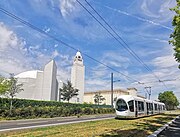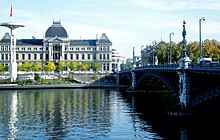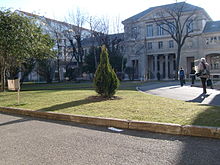Lyon
Lyon
Liyon ( La Part-Dieu Business District | |
|---|---|
EELV) | |
| Area 1 | 47.87 km2 (18.48 sq mi) |
| • Urban (2020[3]) | 1,141.4 km2 (440.7 sq mi) |
| • Metro (2020[4]) | 4,605.8 km2 (1,778.3 sq mi) |
| Population (2021)[5] | 522,250 |
| • Rank | 3rd in France |
| • Density | 11,000/km2 (28,000/sq mi) |
| • Urban (Jan. 2020[6]) | 1,693,159 |
| • Urban density | 1,500/km2 (3,800/sq mi) |
| • Metro (Jan. 2020[7]) | 2,293,180 |
| • Metro density | 500/km2 (1,300/sq mi) |
| Time zone | UTC+01:00 (CET) |
| • Summer (DST) | UTC+02:00 (CEST) |
| INSEE/Postal code | 69123 /69001-69009 |
| Elevation | 162–349 m (531–1,145 ft) |
| Website | www |
| 1 French Land Register data, which excludes lakes, ponds, glaciers > 1 km2 (0.386 sq mi or 247 acres) and river estuaries. | |
Lyon[c] (Franco-Provençal: Liyon), traditionally spelled in English as Lyons,[d] is the third-largest city of France.[e] It is located at the confluence of the rivers Rhône and Saône, to the northwest of the French Alps, 391 km (243 mi) southeast of Paris, 278 km (173 mi) north of Marseille, 113 km (70 mi) southwest of Geneva, 58 km (36 mi) northeast of Saint-Étienne.
The City of Lyon had a population of 522,000 in 2023 within its small municipal territory of 48 km2 (19 sq mi),
The capital of the
Economically, Lyon is a major centre for banking, chemical, pharmaceutical and biotech industries. The city contains a significant software industry with a particular focus on video games; in recent years it has fostered a growing local start-up sector.
History
Toponymy
The name of the city has taken the forms Lugdon, Luon, and since the 13th century, Lyon. The Gallic Lugdun or Lugdunon that was Latinized in Roman as Lugdunum is composed of two words. The first may be the name of the Celtic god Lug (in charge of order and law), or the derived word lugon, meaning "crow" (the crow being the messenger of Lug), but might also be another word lug, meaning "light". The second is dunos ('fortress', 'hill'). The name thus may designate the hill of Fourvière, on which the ancient city of Lyon is founded, but could mean "hill of the god Lug", "hill of the crows" or "shining hill". [20] .
Further down, in the current Saint-Vincent district, was the Gallic village of Condate, probably a simple hamlet of sailors or fishermen living on the banks of the Saône. Condate is a Gallic word meaning "confluence", from which the Confluence district gets its name.
In Roman times the city was called Caput Galliæ, meaning "capital of the Gauls". As an homage to this title, the Archbishop of Lyon is still called the Primate of Gaul.
During the revolutionary period, Lyon was renamed Commune-Affranchie ("
Lyon is called Liyon in Franco-Provençal.[23]
Historical affiliations
Roman Empire (Gallia Lugdunensis), 43 BC-286
Western Roman Empire (Gallia Lugdunensis), 286-411
Kingdom of the Burgundians, 411–534
Francia, 534–843
Middle Francia, 843–855
Lotharingia, 855–879
Lower Burgundy, 879-933
Kingdom of Arles, 933–1312
Kingdom of France (Lyonnais), 1312–1792
French First Republic, 1792–1793
Counter-revolutionary, 1793
French First Republic, 1793–1804
First French Empire, 1804–1814
Kingdom of France, 1814–1815
First French Empire, 1815
Kingdom of France, 1815–1830
Kingdom of France, 1830–1848
French Second Republic, 1848–1852
Second French Empire, 1852–1870
French Third Republic, 1870–1940
Vichy France, 1940–1944
French Fourth Republic, 1944–1958
France, 1958–present
Ancient Lyon
According to the historian
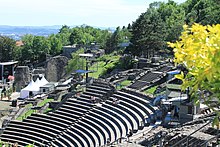
The Romans recognised that Lugdunum's strategic location at the convergence of two navigable rivers made it a natural communications hub. The city became the starting point of main Roman roads in the area, and it quickly became the capital of the province, Gallia Lugdunensis. Two Emperors were born in this city: Claudius, whose speech is preserved in the Lyon Tablet in which he justifies the nomination of Gallic Senators, and Caracalla.
Burgundians fleeing the destruction of Worms by the Huns in 437 were re-settled in eastern Gaul. In 443 the Romans established the Kingdom of the Burgundians, and Lugdunum became its capital in 461. In 843, under the Treaty of Verdun, Lyon went to the Holy Roman Emperor Lothair I. It later was made part of the Kingdom of Arles which was incorporated into the Holy Roman Empire in 1033. Lyon did not come under French control until the 14th century.
Modern Lyon
During the


In 1572, Lyon was a scene of mass violence by Catholics against Protestant
The convention was not the only target within Lyon during the French Revolution. After the Convention faded into history, the French Directory appeared and days after the 4 September 1797 Coup of 18 Fructidor, a Directory's commissioner was assassinated in Lyon.
The city became an important industrial town in the 19th century. In 1831 and 1834, the
During
Geography

The Rhône and Saône converge to the south of the historic city centre, forming a peninsula – the "
The northern hill is La Croix-Rousse, known as "the hill that works" because it is traditionally home to many small silk workshops, an industry for which the city has long been renowned.[34]
The western hill is Fourvière, known as "the hill that prays" because it is the location for
East of the Rhône from the Presqu'île is a large flat area upon which sits much of modern Lyon and contains most of the city's population. Situated in this area is
North of this district lays the sixth arrondissement, which is home to one of Europe's largest urban parks, the Parc de la Tête d'or, as well as Lycée du Parc and Interpol's world headquarters.
Climate
Lyon has a humid subtropical climate (Köppen: Cfa), bordering an oceanic climate (Köppen: Cfb, Trewartha: Do).[37] The mean temperature in Lyon in the coldest month is 4.1 °C (39.4 °F) in January and in the warmest month in July is 22.6 °C (72.7 °F). Precipitation is adequate year-round, at an average of 820 mm (32.3 in), the winter months are the driest. The highest recorded temperature was 40.5 °C (104.9 °F) on 13 August 2003 while the lowest recorded temperature was −24.6 °C (−12.3 °F) on 22 December 1938.[38]
| Climate data for Lyon ( LYN ), elevation: 197 m (646 ft), 1991–2020 normals, extremes 1920–present
| |||||||||||||
|---|---|---|---|---|---|---|---|---|---|---|---|---|---|
| Month | Jan | Feb | Mar | Apr | May | Jun | Jul | Aug | Sep | Oct | Nov | Dec | Year |
| Record high °C (°F) | 19.1 (66.4) |
21.9 (71.4) |
26.0 (78.8) |
30.1 (86.2) |
34.2 (93.6) |
38.4 (101.1) |
40.4 (104.7) |
41.4 (106.5) |
35.8 (96.4) |
28.4 (83.1) |
23.0 (73.4) |
20.2 (68.4) |
41.4 (106.5) |
| Mean daily maximum °C (°F) | 7.1 (44.8) |
9.0 (48.2) |
13.8 (56.8) |
17.4 (63.3) |
21.5 (70.7) |
25.6 (78.1) |
28.2 (82.8) |
28.0 (82.4) |
23.1 (73.6) |
17.7 (63.9) |
11.4 (52.5) |
7.7 (45.9) |
17.5 (63.5) |
| Daily mean °C (°F) | 4.1 (39.4) |
5.2 (41.4) |
9.0 (48.2) |
12.3 (54.1) |
16.3 (61.3) |
20.3 (68.5) |
22.6 (72.7) |
22.3 (72.1) |
17.9 (64.2) |
13.7 (56.7) |
8.1 (46.6) |
4.8 (40.6) |
13.0 (55.4) |
| Mean daily minimum °C (°F) | 1.1 (34.0) |
1.4 (34.5) |
4.2 (39.6) |
7.2 (45.0) |
11.2 (52.2) |
15.0 (59.0) |
17.0 (62.6) |
16.6 (61.9) |
12.8 (55.0) |
9.6 (49.3) |
4.9 (40.8) |
2.0 (35.6) |
8.6 (47.5) |
| Record low °C (°F) | −23.0 (−9.4) |
−22.5 (−8.5) |
−10.5 (13.1) |
−4.4 (24.1) |
−3.8 (25.2) |
2.3 (36.1) |
6.1 (43.0) |
4.6 (40.3) |
0.2 (32.4) |
−4.5 (23.9) |
−9.4 (15.1) |
−24.6 (−12.3) |
−24.6 (−12.3) |
| Average precipitation mm (inches) | 49.8 (1.96) |
41.6 (1.64) |
49.4 (1.94) |
68.9 (2.71) |
80.9 (3.19) |
74.1 (2.92) |
67.4 (2.65) |
65.5 (2.58) |
82.5 (3.25) |
99.8 (3.93) |
87.2 (3.43) |
53.7 (2.11) |
820.8 (32.31) |
| Average precipitation days (≥ 1.0 mm) | 8.1 | 7.9 | 8.4 | 9.0 | 10.3 | 8.5 | 7.5 | 7.2 | 7.3 | 9.9 | 9.4 | 9.2 | 102.8 |
| Mean monthly sunshine hours | 71.1 | 102.4 | 173.7 | 197.7 | 223.8 | 256.5 | 288.1 | 263.1 | 204.1 | 131.4 | 78.9 | 58.7 | 2,049.5 |
| Source 1: Meteo France[39]
| |||||||||||||
| Source 2: Meteo Lyon[40] | |||||||||||||
| Climate data for Lyon (LYN), elevation: 201 m, 1961-1990 normals and extremes | |||||||||||||
|---|---|---|---|---|---|---|---|---|---|---|---|---|---|
| Month | Jan | Feb | Mar | Apr | May | Jun | Jul | Aug | Sep | Oct | Nov | Dec | Year |
| Record high °C (°F) | 16.3 (61.3) |
21.4 (70.5) |
25.7 (78.3) |
28.0 (82.4) |
29.4 (84.9) |
34.4 (93.9) |
39.8 (103.6) |
37.1 (98.8) |
33.8 (92.8) |
28.4 (83.1) |
22.6 (72.7) |
20.2 (68.4) |
39.8 (103.6) |
| Mean maximum °C (°F) | 10.2 (50.4) |
14.4 (57.9) |
15.9 (60.6) |
18.6 (65.5) |
23.1 (73.6) |
28.8 (83.8) |
32.8 (91.0) |
28.1 (82.6) |
27.3 (81.1) |
19.7 (67.5) |
14.1 (57.4) |
9.5 (49.1) |
32.8 (91.0) |
| Mean daily maximum °C (°F) | 6.1 (43.0) |
8.2 (46.8) |
11.6 (52.9) |
15.2 (59.4) |
19.1 (66.4) |
22.9 (73.2) |
26.1 (79.0) |
26.0 (78.8) |
22.4 (72.3) |
17.1 (62.8) |
10.0 (50.0) |
6.4 (43.5) |
15.9 (60.7) |
| Daily mean °C (°F) | 3.0 (37.4) |
4.9 (40.8) |
7.4 (45.3) |
10.2 (50.4) |
14.0 (57.2) |
17.6 (63.7) |
20.6 (69.1) |
20.0 (68.0) |
17.1 (62.8) |
12.7 (54.9) |
6.7 (44.1) |
3.9 (39.0) |
11.5 (52.7) |
| Mean daily minimum °C (°F) | 0.2 (32.4) |
1.4 (34.5) |
2.9 (37.2) |
5.2 (41.4) |
9.1 (48.4) |
12.5 (54.5) |
14.8 (58.6) |
14.4 (57.9) |
11.7 (53.1) |
8.3 (46.9) |
3.5 (38.3) |
0.7 (33.3) |
7.1 (44.7) |
| Mean minimum °C (°F) | −7.0 (19.4) |
−4.7 (23.5) |
−1.4 (29.5) |
3.2 (37.8) |
7.6 (45.7) |
10.9 (51.6) |
13.1 (55.6) |
12.9 (55.2) |
8.1 (46.6) |
4.5 (40.1) |
1.0 (33.8) |
−4.7 (23.5) |
−7.0 (19.4) |
| Record low °C (°F) | −23.0 (−9.4) |
−19.3 (−2.7) |
−10.5 (13.1) |
−3.2 (26.2) |
−0.3 (31.5) |
3.6 (38.5) |
6.1 (43.0) |
5.2 (41.4) |
1.9 (35.4) |
−3.2 (26.2) |
−7.1 (19.2) |
−16.0 (3.2) |
−23.0 (−9.4) |
| Average precipitation mm (inches) | 54.0 (2.13) |
53.8 (2.12) |
72.2 (2.84) |
56.1 (2.21) |
72.6 (2.86) |
73.2 (2.88) |
54.5 (2.15) |
71.6 (2.82) |
53.2 (2.09) |
56.2 (2.21) |
68.0 (2.68) |
55.8 (2.20) |
741.2 (29.19) |
| Average precipitation days (≥ 1.0 mm) | 10.4 | 9.3 | 9.7 | 9.6 | 10.9 | 8.2 | 6.8 | 8.2 | 7.3 | 8.5 | 8.9 | 9.8 | 107.6 |
| Average snowy days | 5.5 | 3.9 | 2.5 | 1.1 | 0.0 | 0.0 | 0.0 | 0.0 | 0.0 | 0.0 | 2.0 | 4.6 | 19.6 |
| Average relative humidity (%)
|
84 | 80 | 74 | 71 | 72 | 70 | 65 | 70 | 76 | 82 | 84 | 86 | 76 |
| Mean monthly sunshine hours | 62.6 | 89.8 | 147.5 | 184.2 | 215.9 | 250.9 | 292.6 | 259.0 | 208.1 | 134.3 | 75.3 | 55.4 | 1,975.6 |
| Percent possible sunshine | 23 | 31 | 41 | 46 | 47 | 54 | 62 | 60 | 56 | 40 | 27 | 21 | 42 |
| Source 1: NOAA[41] | |||||||||||||
| Source 2: Infoclimat.fr (humidity)[42] | |||||||||||||
Administration
Commune
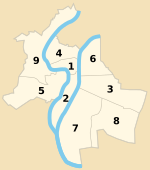
Like Paris and Marseille, the commune (municipality) of Lyon is divided into a number of municipal arrondissements, each of which is identified by a number and has its own council and town hall. Five arrondissements were originally created in 1852, when three neighbouring communes (La Croix-Rousse, La Guillotière, and Vaise) were annexed by Lyon. Between 1867 and 1959, the third arrondissement (which originally covered the whole of the Left Bank of the Rhône) was split three times, creating a new arrondissement in each case. Then, in 1963, the commune of Saint-Rambert-l'Île-Barbe was annexed to Lyon's fifth arrondissement. A year later, in 1964, the fifth was split to create Lyon's 9th – and, to date, final – arrondissement. Within each arrondissement, the recognisable quartiers or neighbourhoods are:
- 1st arrondissement: Slopes of La Croix-Rousse, Terreaux, Martinière/St-Vincent
- 2nd arrondissement: Cordeliers, Bellecour, Ainay, Perrache, Confluence, Sainte-Blandine
- 3rd arrondissement: Guillotière (north), Préfecture, Part-Dieu, Villette, Dauphiné/Sans Souci, Montchat, Grange Blanche (north), Monplaisir (north)
- 4th arrondissement: Plateau de la Croix-Rousse, Serin
- 5th arrondissement: Vieux Lyon (Saint-Paul, Saint-Jean, Saint-Georges), Saint-Just, Saint-Irénée,[43] Fourvière, Point du Jour, Ménival, Battières, Champvert (south)
- 6th arrondissement: Brotteaux, Bellecombe, Parc de la Tête d'or, Cité Internationale
- 7th arrondissement: Guillotière (south), Jean Macé, Gerland
- 8th arrondissement: Monplaisir (south), Bachut, États-Unis, Grand Trou/Moulin à Vent, Grange Blanche (south), Laënnec, Mermoz, Monplaisir-la-Plaine
- 9th arrondissement: Vaise, Duchère, Rochecardon, St-Rambert-l'Île-Barbe, Gorge de Loup, Observance, Champvert (north)
Geographically, Lyon's two main rivers, the Saône and the Rhône, divide the arrondissements into three groups:
- To the west of the Saône, the fifth arrondissement covers the old city of Vieux Lyon, Fourvière hill and the plateau beyond. The 9th is immediately to the north, and stretches from Gorge de Loup, through Vaise to the neighbouring suburbs of Écully, Champagne-au-Mont-d'Or, Saint-Didier-au-Mont-d'Or, Saint-Cyr-au-Mont-d'Or and Collonges-au-Mont-d'Or.
- Between the two rivers, on the Presqu'île, are the second, first, and fourth arrondissements. The second includes most of the city centre, Bellecour and Perrache railway station, and reaches as far as the confluence of the two rivers. The first is directly to the north of the second and covers part of the city centre (including the Hôtel de Ville) and the slopes of La Croix-Rousse. To the north of the Boulevard is the fourth arrondissement, which covers the Plateau of La Croix-Rousse, up to its boundary with the commune of Caluire-et-Cuire.
- To the east of the Rhône, are the third, sixth, seventh, and eighth arrondissements.
Mayors
This is a list of mayors of the commune of Lyon since the end of the 19th century.
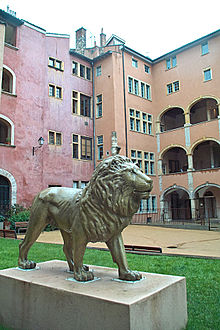
| Mayor | Term start | Term end | Party | |
|---|---|---|---|---|
| Antoine Gailleton | 1881 | 1900 | ||
| Victor Augagneur | 1900 | 30 October 1905 | PRS | |
| Édouard Herriot | 30 October 1905 | 20 September 1940 | Radical
| |
| Georges Cohendy | 20 September 1940 | 1941 | Nominated and dismissed by Vichy | |
| Georges Villiers | 1941 | 1942 | Nominated and dismissed by Vichy | |
| Pierre-Louis-André Bertrand | 1942 | 1944 | Nominated by Vichy | |
| Justin Godart | 1944 | 18 May 1945 | Radical
| |
| Édouard Herriot | 18 May 1945 | 26 March 1957 | Radical
| |
| Pierre Montel, ad interim | 26 March 1957 | 14 April 1957 | Radical
| |
| Louis Pradel | 14 April 1957 | 27 November 1976 | DVD
| |
| Armand Tapernoux, ad interim | 27 November 1976 | 5 December 1976 | DVD
| |
| Francisque Collomb | 5 December 1976 | 24 March 1989 | DVD
| |
| Michel Noir | 24 March 1989 | 25 June 1995 | RPR | |
| Raymond Barre | 25 June 1995 | 25 March 2001 | DVD
| |
| Gérard Collomb | 25 March 2001 | 17 July 2017 | PS | |
| Georges Képénékian | 17 July 2017 | 5 November 2018 | LREM
| |
| Gérard Collomb | 5 November 2018 | 4 July 2020 | LREM
| |
| Grégory Doucet | 4 July 2020 | Incumbent | EELV
|
Metropolis

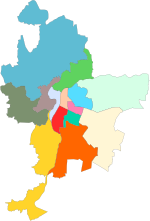
Since 2015, the commune of Lyon (48 km2 (19 sq mi) in land area) and 58 suburban communes have formed the Metropolis of Lyon (534 km2 (206 sq mi) in land area), a directly elected metropolitan authority now in charge of most urban issues. The Metropolis of Lyon is the only metropolitan authority in France which is a territorial collectivity, on par with French communes and departments. Its metropolitan council was for the first time directly elected by universal suffrage in 2020 within 14 electoral wards, the only directly elected metropolitan council in France.
The 14 electoral wards are the following (see map for location):
The six wards with names starting with "Lyon" are all located within the commune of Lyon. The Villeurbanne ward is coterminous with the namesake commune. All other seven wards each group various suburban communes.
The division of the Metropolis of Lyon in large electoral wards often grouping various communes and dividing the commune of Lyon into six wards was criticized by the suburban mayors, as it ended the rule of 'one commune, one metropolitan councilor'. The goal of this electoral division of the metropolis was to focus metropolitan elections more on metropolitan issues than parochial communal issues, and ensure the 'one person, one vote' rule be respected, by creating electoral wards of more homogeneous population sizes. Opponents said it diluted the voice of the small suburban communes, which are now part of large electoral wards and do not each possess a representative in the metropolitan council anymore.
Presidents of the Metropolitan Council
The two first presidents of the Metropolis of Lyon's metropolitan council were chosen by indirectly elected metropolitan councilors. The current president since July 2020 was elected by new metropolitan councilors following their election by universal suffrage in March (1st round) and June (2nd round) 2020, the first direct election of a metropolitan council in France.
| President of the Metropolitan Council | Term start | Term end | Party | |
|---|---|---|---|---|
| Gérard Collomb | 1 January 2015 | 10 July 2017 | PS | |
| David Kimelfeld | 10 July 2017 | 2 July 2020 | LREM
| |
| Bruno Bernard | 2 July 2020 | Incumbent | EELV
|
Main sights
Antiquity
- The Roman ruins on the hillside near the Fourvière Basilica, with the Ancient Theatre of Fourvière, the Odeon of Lyon and the accompanying Gallo-Roman museum
- Amphitheatre of the Three Gauls – ruins of a Roman amphitheatre.
Middle Ages and Renaissance
- Archbishop of Lyon
- Basilica of St-Martin-d'Ainay, one of the rare surviving Romanesque basilica-style churches in Lyon
- Église Saint-Paul, Romanesque (12th and 13th century) and Gothic (15th–16th century) church
- Église Saint-Bonaventure, 14th- and 15th-century Gothic church
- Église Saint-Nizier, Gothic church from the 15th century, having a doorway carved in the 16th century by Philibert Delorme
- Vieux Lyon (English: Old Lyon) area, Medieval and Renaissance quarter of the town, with shops, dining and cobbled streets
- The many Renaissance hôtels particuliers of the Old Lyon quarter, such as the Hôtel de Bullioud, were also built by Philibert Delorme
17th and 18th centuries
- City Hall on the Place des Terreaux, built by architects Jules Hardouin-Mansart and Robert de Cotte
- Musée des beaux-arts de Lyon, fine arts museum housed in a former convent of the 17th century, including the Baroque chapelle Saint-Pierre
- Hôtel-Dieu de Lyon (17th and 18th century), historical hospital with a baroque chapel
- Temple du Change (17th and 18th century), former stock exchange of Lyon, Protestant temple since the 18th century
- Place Bellecour, one of the largest town squares in Europe
- Chapelle de la Trinité (1622), the first Baroque chapel built in Lyon, and part of the former École de la Trinité, now Collège-lycée Ampère
- Église Saint-Polycarpe (1665–1670), Classical church
- Église Saint-Just (16th to 18th century), Classical church
- Saint-Bruno des Chartreux(17th and 18th century), church, masterpiece of Baroque architecture
- Église Notre Dame Saint-Vincent (18th century), Neo-classical church
19th century and modern city
- Opéra Nouvel (1831), renovated in 1993 by Jean Nouvel
- Théâtre des Célestins (1877), designed by Gaspard André
- Basilica of Notre-Dame de Fourvière, large 19th-century basilica on the top of Fourvière Hill
- Tour métallique de Fourvière (1894)
- Vacherie du Parc (1904-1905), designed by Tony Garnier.
- La Mouche Cattle Market and Abattoir (1914, 1928), also by Garnier
- Sainte Marie de La Tourette monastery (1960) designed by Le Corbusier
- Saint-Exupéry International Airport (formerly Satolas Airport), designed by Guillaume Gillet]
- Gare de Lyon Saint-Exupéry (1994) by Santiago Calatrava
- Palais des congrès de Lyon (1998), designed by Renzo Piano and a group of buildings for various functions
- Tour du Crédit Lyonnais
- Tour Oxygène
- Tour Incity
- Great mosque of Lyon
Museums

- Francis Bacon...); collections of sculptures, drawings and printings, decorative arts, Roman and Greek antiquities; the second largest collection of Egyptian antiquities in France after that of the Louvre; and a medal cabinet of 50.000 medals and coins.
- The Gallo-Roman Museum displaying many valuable objects and artworks found on the site of Roman Lyon (Lugdunum) such as Circus Games Mosaic, Coligny calendar and the Taurobolic Altar
- Centre d'histoire de la résistance et de la déportation
- Musée des Confluences, new museum of sciences and anthropology, which opened its doors on 20 December 2014
- La Sucrière, contemporary art centre
- Hôtel-Dieu de Lyon houses the "Musée des Hospices Civils", a permanent exhibit tracing the history and practice of medicine from the Middle Ages to modern times
- Musée des Tissus et des Arts décoratifs, decorative arts and textile museum, which is one of the world's larger textile collections with 2.5 million works
- Musée d'art contemporain de Lyon, contemporary art museum
- Musée de L'imprimerie, printing museum
- Musée Gadagne, museum of the history of Lyon housed in a historic building in Vieux Lyon, which includes a large collection of marionettes
- Musée des Automates, museum of automated puppets in Vieux Lyon, open since 1991
- Musée Miniature & Cinéma, museum featuring miniature movie sets, movie props, and special effects[44]
Parks and gardens
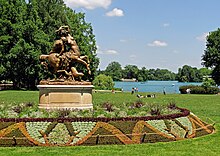
- Parc de la Tête d'or, aka Golden Head Park, in central Lyon is the largest urban park in France at 117 hectares (290 acres). Located in the 6th arrondissement, it features a large lake on which boating takes place during the summer months.
- Jardin botanique de Lyon (8 hectares (20 acres)), included in the Parc de la Tête d'Or, is a municipal botanical garden and is open weekdays without charge. The garden was established in 1857 as a successor to earlier botanical gardens dating to 1796, and now describes itself as France's largest municipal botanical garden.
- Parc de Gerland, in the south of the city (80 hectares (200 acres))
- Parc des hauteurs, in Fourvières
- Parc de Miribel-Jonage(2,200 hectares (5,400 acres))
- Parc de Lacroix-Laval (115 hectares (280 acres))
- Parc de Parilly (178 hectares (440 acres))
Economy
The GDP of Lyon was 124 billion US dollars in 2019,
The city is home to the headquarters of many large companies such as
Tourism is an important part of the Lyon economy, with one billion euros in 2007 and 3.5 million hotel-nights in 2006 provided by non-residents.[citation needed] Approximately 60% of tourists visit for business, with the rest for leisure.[citation needed] In January 2009, Lyon ranked first in France for hostels business.[citation needed] The festivals most important for attracting tourists are the Fête des lumières, the Nuits de Fourvière every summer, the Biennale d'art contemporain and the Nuits Sonores.
Culture
Basilica Notre-Dame de Fourvière | |
|---|---|
| Criteria | Cultural: (ii)(iv) |
| Reference | 872 |
| Inscription | 1998 (22nd Session) |
| Area | 427 ha (1,060 acres) |
| Buffer zone | 323 ha (800 acres) |
Since the Middle Ages, the region residents have spoken several dialects of Franco-Provençal. The Lyonnais dialect was replaced by the French language as the importance of the city grew. However some "frenchified" Franco-Provençal words can also be heard in the French of the Lyonnais, who call their little boys and girls "gones" and "fenottes" for example.[48]
- The Lumière brothers pioneered cinema in the town in 1895. The Institut Lumière, built as Auguste Lumiere's house, and a fascinating piece of architecture in its own right, holds many of their first inventions and other early cinematic and photographic artifacts.
- 8 December each year is marked by the Festival of Lights (la Fête des lumières), a celebration of thanks to the Virgin Mary, who purportedly saved the city from a deadly plague in the Middle Ages. During the event, the local population places candles (luminions) at their windows and the city of Lyon organizes large-scale light shows onto the sides of important Lyonnais monuments, such as the medieval Cathédrale St-Jean.
- The Saint Francis of Sales church is famous for its large and unaltered Cavaillé-Coll pipe organ, attracting audiences from around the world.
- The Opéra Nouvel (New Opera House) is the home of the Opéra National de Lyon. The original opera house was re-designed by the distinguished French architect Jean Nouvel between 1985 and 1993 and is named after him.
- Lyon is also the French capital of "trompe l'œil" walls, a very ancient tradition. Many are to be seen around the city. This old tradition is now finding a contemporary expression, for example in the art of Guillaume Bottazzi.[49][50]
- The Brothers of the Sacred Heart, a Roman Catholic congregation that operates schools in Europe and North America, was founded in Lyon in 1821.
- The African Museum of Lyon is one of the oldest museums situated in Lyon.[51]
- The Museum of Resistance and Deportation looks at the various individuals prominent in the Resistance movement in World War II. The building is strongly linked to Klaus Barbie. Lyon sees itself as the centre of the French resistance and many members were shot in Place Bellecour in the town centre. The exhibition is largely a series of mini-biographies of those involved.
- Lyon is a pilot city of the Council of Europe and the European Commission Intercultural cities program.
UNESCO World Heritage Site

The historic site of Lyon was designated a UNESCO World Heritage Site in 1998. In its designation, UNESCO cited the "exceptional testimony to the continuity of urban settlement over more than two millennia on a site of great commercial and strategic significance."[36] The specific regions comprising the historic site include the Roman district and Fourvière, the Renaissance district (Vieux Lyon), the silk district (slopes of Croix-Rousse), and the Presqu'île, which features architecture from the 12th century to modern times.[52]
Both Vieux Lyon and the slopes of Croix-Rousse are known for their narrow passageways (named traboules) that pass through buildings and link streets on either side. The first examples of traboules are thought to have been built in Lyon in the 4th century.[53] The traboules allowed the inhabitants to get from their homes to the Saône quickly and allowed the canuts on the Croix-Rousse hill to get from their workshops to the textile merchants at the foot of the hill.
Gastronomy

Lyon has a long and chronicled culinary arts tradition. The noted food critic Curnonsky referred to the city as "the gastronomic capital of the world",[54] a claim repeated by later writers such as Bill Buford.[55] Renowned 3-star Michelin chefs such as Marie Bourgeois[56] and Eugénie Brazier[57] developed Lyonnaise cuisine into a national phenomenon favoured by the French elite; a tradition which Paul Bocuse later turned into a worldwide success.[58]
The
Other traditional local dishes include
More recently, the french tacos was invented in Lyon suburbs in the early 2000s and is now famous worldwide.
Sport
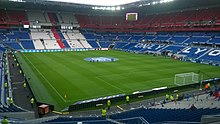
Lyon is home to the
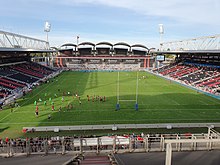
Lyon has a
Lyon is also home to the
Street art
Since 2000, Birdy Kids, a group of graffiti artists from the city, has decorated several random buildings and walls along the Lyon ring road. In 2012, the artist collective was chosen to represent the city as its cultural ambassadors.[63]
Demographics
The population of the city (commune) of Lyon proper was 522,969 at the January 2019 census.[14] As of 2011, 14% of its population was born outside Metropolitan France.[64]
|
|
| |||||||||||||||||||||||||||||||||||||||||||||||||||||||||||||||||||||||||||||||||||||||||||||||||||||||||||||||||||||||||
Foreign-born
The city of Lyon and 58 suburban municipalities have formed since 2015 the Metropolis of Lyon, a directly elected metropolitan authority now in charge of most urban issues, with a population of 1,411,571 in 2019.[15]
| |||||||||||||||||||||||||||||||||||||||||||||||||||||||||||||||||||||||||||||||||||||||||||||||||||||||||||||||||||||||||||




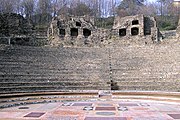


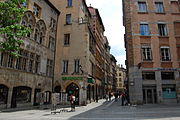

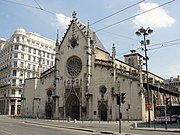




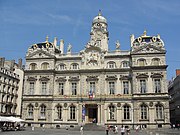



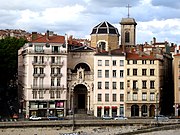

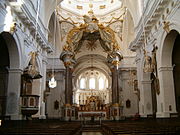

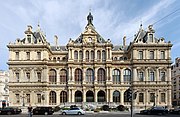


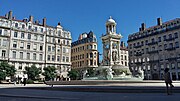

![Arch-epsicopal palace of Lyon [fr] (5th district public library)](http://upload.wikimedia.org/wikipedia/commons/thumb/c/c9/Lyon_Biblioth%C3%A8que_Municipale_--_Saint-Jean.jpg/129px-Lyon_Biblioth%C3%A8que_Municipale_--_Saint-Jean.jpg)


